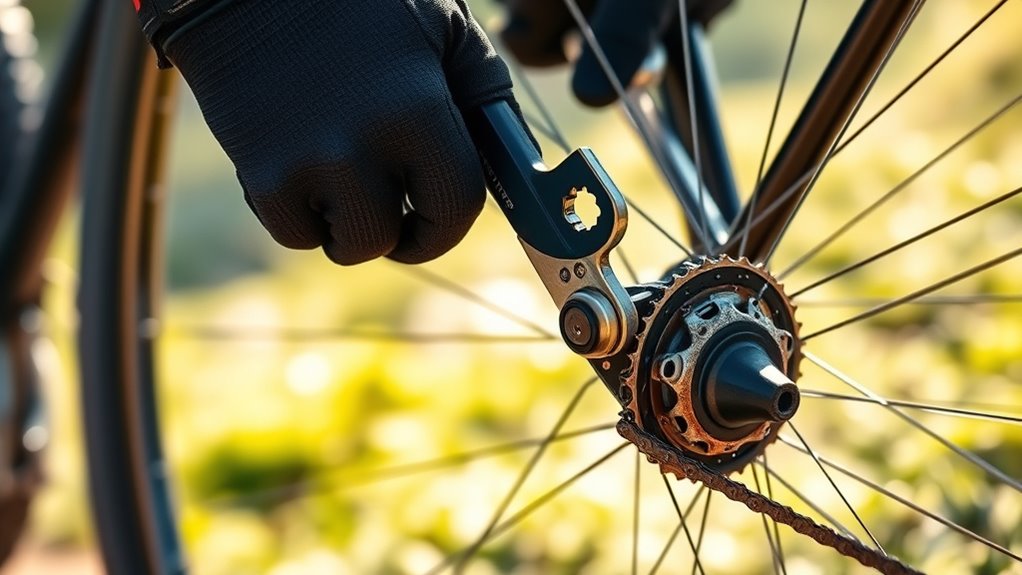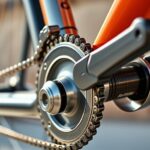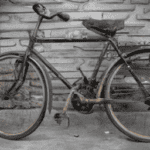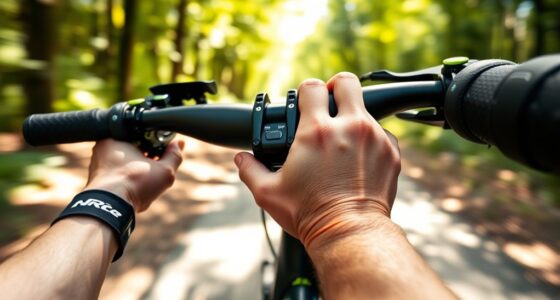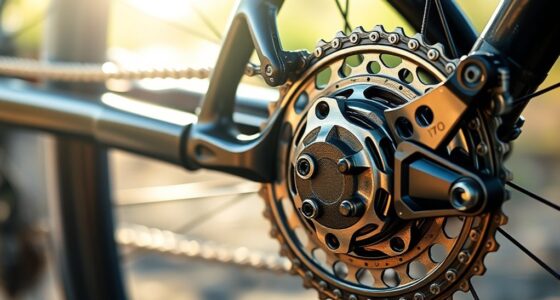To keep your bike in top shape, regularly check your tires for proper pressure, cracks, and tread wear, and verify your wheels spin smoothly without wobbling. Clean and protect your bike using soft brushes and avoid debris buildup. Lubricate your chain often and tighten bolts, quick releases, and screws. Regularly inspect your brakes, gears, and fasteners for wear or looseness. Stay on top of basic maintenance, and you’ll enjoy safer, smoother rides every time.
Key Takeaways
- Regularly check and maintain tire pressure and inspect tires for damage to ensure safety and optimal performance.
- Keep the bike clean, dry, and lubricated, especially the chain and drivetrain, to prolong component life.
- Tighten bolts, quick releases, and fasteners weekly using a torque wrench, following manufacturer specifications.
- Inspect brake pads, rotors, and cables regularly; replace worn parts to ensure effective braking.
- Test electronic features and sensors if equipped, and keep firmware updated for safety and connectivity.
Regularly Inspect Your Tires and Wheels
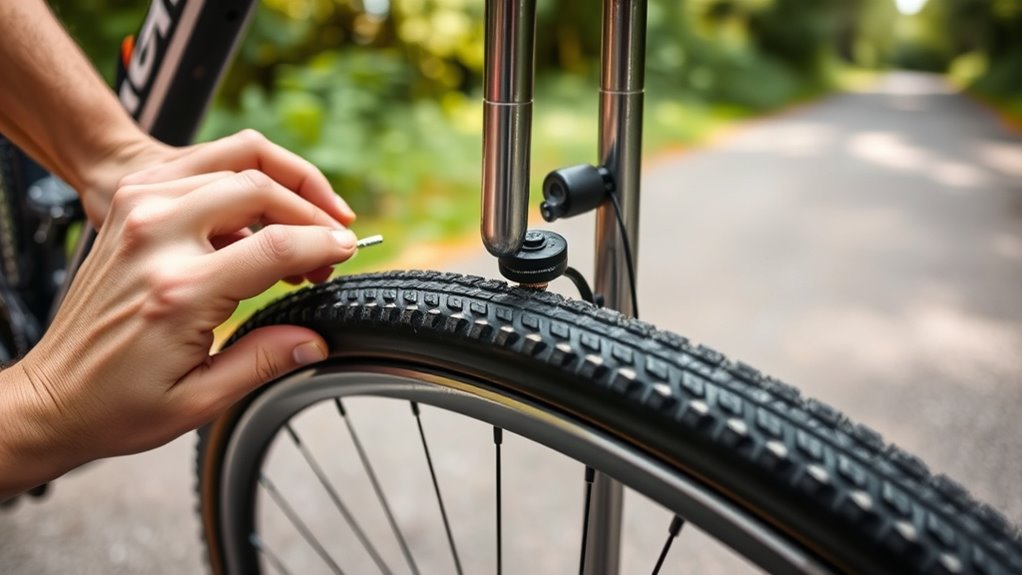
Regularly inspecting your tires and wheels is essential for safe and efficient riding. Use a gauge to verify the PSI, matching the number on the tire sidewall.
Regularly check tire pressure to ensure safe, smooth rides and prevent damage.
Under-inflation increases rolling resistance and risks damage, while over-inflation reduces grip and raises blowout chances. Check weekly or before each ride, especially during seasonal changes, since temperature affects air pressure.
Examine the tires for cracks, cuts, tears, or bulges, which indicate damage. Look for uneven tread wear that signals alignment or inflation issues. Proper tire pressure is crucial for optimal grip and safety, affecting how well your bike handles and its overall performance.
Ensure the bead seats properly on the rim, and remove debris from treads to prevent punctures. Spin wheels to check for wobble or brake contact, and test quick-release levers for security. Additionally, inspecting tire maintenance can prevent common issues and extend the lifespan of your tires. Regularly checking tire pressure variation can also help identify potential problems early. Maintaining bike handling through proper tire care enhances safety and riding experience.
Regular inspections keep your ride smooth, safe, and ready for any adventure. Paying attention to tire pressure variation and its impact on safety is crucial for preventing accidents.
Keep Your Bike Clean and Protected
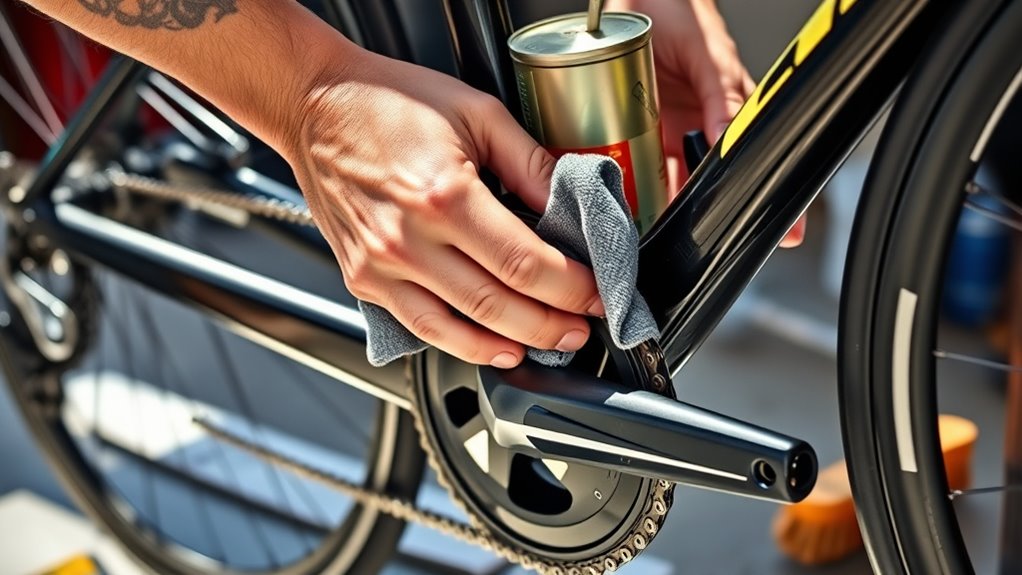
Keeping your bike clean and protected is essential for maintaining its performance and longevity. Use soft rags and brushes to gently remove dirt from the frame, wheels, and components.
Start by rinsing your bike with water, either from a hose or bucket, to loosen loose dirt.
Apply degreasers to the chain and drivetrain, then scrub with stiff brushes for thorough cleaning.
Use softer brushes for tires and rims to avoid damage.
After cleaning, dry your bike with a clean rag to prevent water spots.
Consider applying a protective coating or wax to metal parts for extra protection against rust.
Storing your bike in a dry environment and maintaining proper color accuracy] can further extend its lifespan and keep it looking new.
Store your bike in a dry environment, and establish a regular cleaning routine to keep it in top shape.
Proper cleaning helps prevent deterioration and ensures smooth rides.
Maintain Proper Lubrication and Chain Care

A clean, protected bike performs better, but proper lubrication and chain care are what keep it running smoothly over time. To do this, choose lubricants suited for your riding conditions—wet or dry—and apply them directly onto the chain rollers. Afterward, remove excess lubricant to prevent dirt buildup, and backpedal to spread it evenly across inner surfaces. Regular lubrication is essential, especially after washing or riding in wet weather. Clean your chain monthly with a bike-specific degreaser, using a brush or chain cleaning tool, then rinse with soapy water. Checking for wear signs like rust or stretch can help you determine when to replace the chain, which is crucial to avoid damaging other drivetrain components. Replacing the chain when necessary prevents damage to other parts and extends the lifespan of your entire drivetrain. Proper chain maintenance extends its lifespan, improves efficiency, and makes your rides smoother. Additionally, understanding keto diet principles can enhance your overall health and energy levels during rides. Incorporating proper bike storage practices can also protect your components from the elements and prolong their usability. Maintaining a consistent maintenance routine ensures your bike stays in top condition and reduces the likelihood of costly repairs.
Check and Tighten Bolts, Screws, and Quick Releases
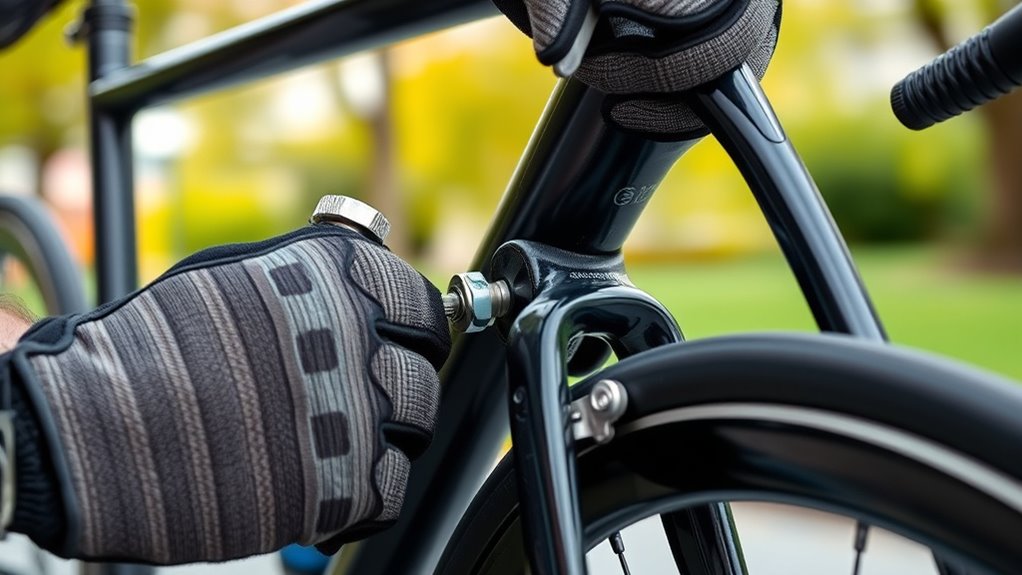
Checking and tightening your bike’s bolts, screws, and quick releases is essential before every ride to guarantee safety and ideal performance. Weekly inspections help prevent loosening from vibrations, especially on high-priority components like the stem, crank, seatpost, brakes, and derailleur mounts. Regularly monitoring fastener tightness can help catch issues early before they compromise safety. Use a torque wrench for precise tightening—most alloy bolts require 4-8 Nm, while carbon parts need manufacturer-specific specs. Grease threads on seatpost and stem bolts to prevent corrosion and ensure proper clamping. Always follow the correct tightening sequence for components with multiple bolts, and check quick-release tension so the lever leaves a visible imprint on your palm when closed. Watch for any movement, creaking, or gaps; these indicate loose fasteners needing immediate attention. Properly maintained bolts keep your ride safe and reliable. Additionally, regularly inspecting your bike’s fastener security can help identify potential issues before they become safety hazards. Ensuring proper torque during tightening can prevent damage to sensitive components and prolong their lifespan.
Monitor and Adjust Brakes and Gears
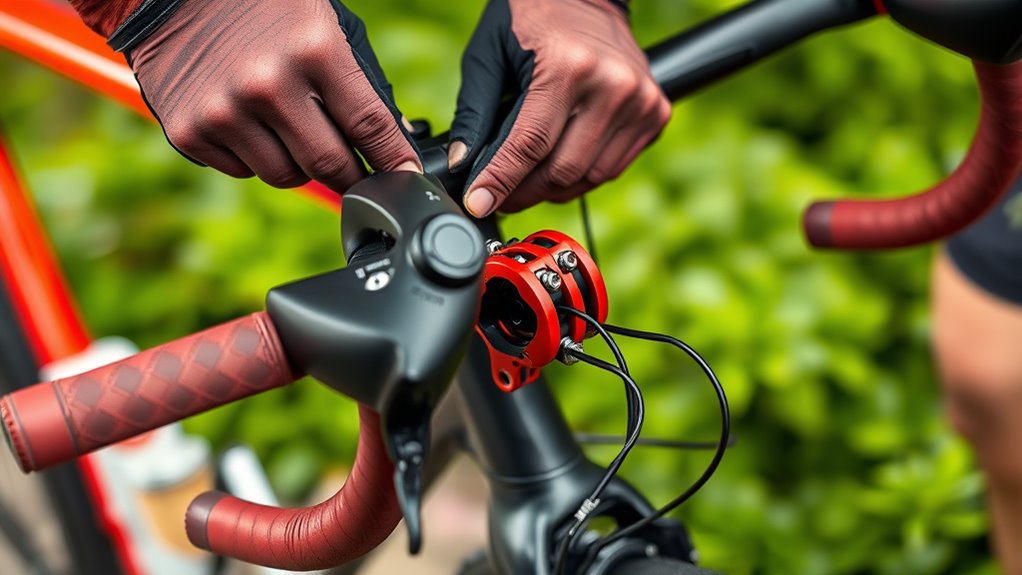
Monitoring and adjusting your brakes and gears regularly guarantees safe and smooth rides. Start by inspecting brake pads, rotors, levers, and cables for wear or damage. For hydraulic brakes, bleed lines to remove air bubbles that cause spongy levers. Keep brake components clean with compressed air and wipes, and address squeals by toeing in pads or sanding them. Additionally, utilizing powerful persuasive words can help you remember the importance of regular maintenance to keep your bike performing optimally. Adjust brake pad distance with caliper dials, replacing pads when less than a quarter inch thick, and ensure proper alignment to prevent uneven wear. Proper filtration in your maintenance routines can also help prevent dirt and debris from causing damage to brake components. Regular cleaning and inspection are crucial to maintain component longevity and optimal performance. Incorporating routine checks for wear and tear can further extend the lifespan of your brake system. Including essential oils for brake maintenance can assist in cleaning and maintaining optimal performance of your components. For gears, lubricate the chain, adjust cable tension, and align derailleurs for accurate shifting. Use barrel adjusters for fine-tuning, and regularly check cassette and chainring wear. Proper maintenance keeps your brakes and gears responsive, ensuring safer, more efficient rides.
Conduct Advanced Checks for Safety and Performance
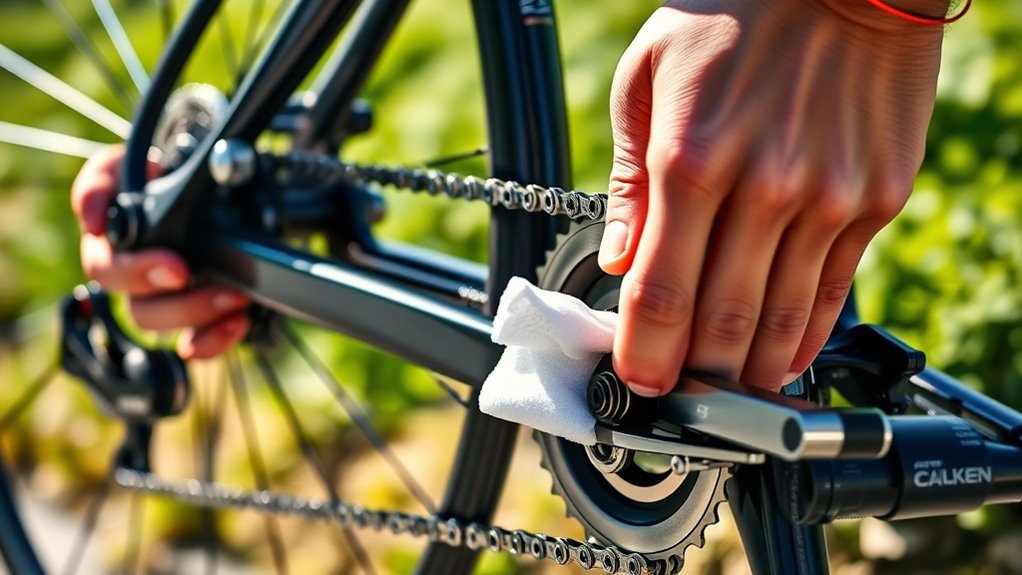
Performing advanced checks on your bike’s components guarantees it remains safe and responsive during rides. Regularly inspect your wheels for wobbles, bent rims, or loose spokes, and check the hub for grinding sounds or resistance, which signal lubrication or replacement needs. Guarantee your wheels are balanced and true to prevent accidents. Additionally, ensure your bike’s sensors and navigation features are functioning properly if it is equipped with advanced technology. Examine rims for wear or damage, and keep tires properly inflated for ideal performance. For steering, verify that the stem is tight, the headset rotates smoothly, and handlebars don’t wobble. Check suspension function and fork alignment for stability. Inspect the chain for wear and proper lubrication, and confirm gears and pedals operate smoothly. Tighten bolts, secure the seatpost, and ensure wheels are firmly attached for overall safety and performance. Regularly lubricate moving parts and replace worn components to keep your bike in optimal condition. Also, inspecting your gumball machine locations can help you understand common placement areas and maintain proper hygiene standards.
Frequently Asked Questions
How Often Should I Replace My Bike Tires?
You should replace your bike tires based on mileage, age, and wear indicators. Typically, road tires last around 2,500–4,000 km, while mountain bike tires may need changing every 1,500–3,000 km.
Also, replace them every 3–5 years regardless of tread, especially if you notice cracks or damage.
Keep an eye on tread wear, sidewall condition, and ride quality to determine when it’s time for new tires.
What’S the Best Way to Clean a Greasy Chain?
To clean a greasy chain effectively, start by applying a bike-specific degreaser liberally to the chain. Use a brush or chain cleaner tool to scrub while backpedaling, focusing on greasy spots.
Rinse thoroughly with water to remove all degreaser and grime. Dry the chain completely to prevent rust, then apply a suitable lubricant.
Regular cleaning keeps your chain smooth, prolongs its life, and guarantees better bike performance.
How Can I Tell if My Bike’S Bearings Need Re-Greasing?
To tell if your bike’s bearings need re-greasing, pay attention to signs like grinding, gritty feels, or stiff rotation when you spin wheels or move components.
Excessive play or looseness also indicates worn bearings.
If you notice creaking, knocking noises, or resistance during pedaling, it’s time to inspect and re-grease.
Regular checks after muddy or wet rides help prevent issues and keep your bike running smoothly.
When Should Brake Pads Be Replaced?
Imagine your bike’s brakes as a trusty guardian guarding your ride. When you notice less stopping power, squealing, or the brake lever feels spongy, it’s time for new pads.
Check the grooves or thickness—if they’re gone or under 1mm, replace them immediately. Uneven wear or metal-on-metal contact also signals it’s time.
Regular inspections keep your brakes reliable, ensuring safe, confident rides every time.
How Do I Fix a Loose Spoke on My Wheel?
When you notice a loose spoke on your wheel, start by tightening it with a spoke key, turning the nipple in small increments.
If it’s near the rotor, secure the spoke temporarily with zip ties or duct tape to prevent interference.
Check the wheel’s true using brake pads as a guide, and avoid over-tightening to prevent damage.
If the spoke remains loose or the wheel wobbles, consider visiting a professional for proper tensioning and trueing.
Conclusion
Just like a trusted steed, your bike needs regular care to keep you riding smoothly. Think of yourself as the guardian of your two-wheeled companion, ensuring every part is in top shape. By staying vigilant with these simple maintenance tips, you’ll avoid unexpected breakdowns and channel your inner hero, much like a knight preparing for battle. Keep your bike in prime condition, and adventure will always be just a pedal stroke away.
